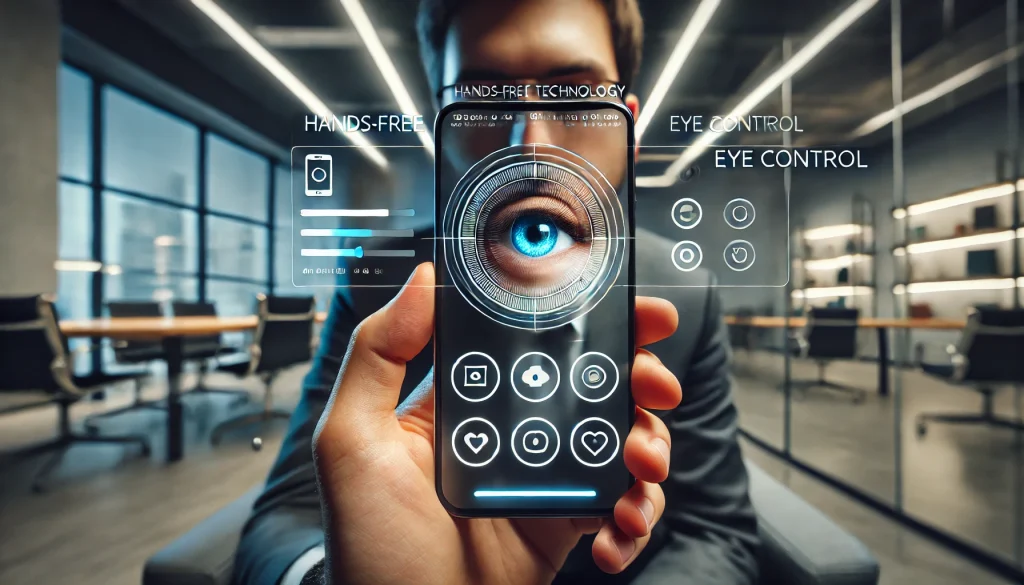
Imagine controlling your phone, tablet, or computer without lifting a finger—simply by moving your eyes. What sounds like science fiction has now become a reality thanks to eye control technology. With the rise of accessibility tools and advancements in AI, eye-tracking and eye control are transforming how we interact with our devices, offering an intuitive, hands-free way to navigate apps, send messages, and even play games.
Master Your Device with Eye Control
Whether you’re someone who values convenience, a gamer looking to enhance your experience, or someone with limited mobility, eye control opens up a world of possibilities for interacting with your device in a whole new way.
What is Eye Control?
Eye control (also known as eye-tracking technology) uses cameras and sensors to track the movement of your eyes and translate it into commands for your device. By detecting where you are looking on the screen, these systems allow you to move a cursor, scroll through pages, or even click on items—without touching the screen or using a mouse.
For users with disabilities, eye control offers an unprecedented level of independence and ease of access. But beyond accessibility, eye control is quickly being integrated into everyday devices, offering hands-free convenience for tasks like web browsing, text input, and gaming.
How Eye Control Works
Eye control technology relies on advanced eye-tracking cameras and software algorithms to track the movements of your pupils in real-time. Here’s a simplified look at how the process works:
- Camera Sensors: A specialized camera (often infrared) is used to track your eye movements. It detects where your eyes are looking on the screen.
- Calibration: The device is calibrated to match your specific eye movements with the cursor or command functions. This typically involves following a series of points on the screen with your eyes so the system can learn how to respond to your gaze.
- Gaze Detection: Once calibrated, the system follows your gaze and interprets your eye movement as commands. For example, if you stare at an icon for a set period of time (known as a “dwell time”), the system will click on it.
- Eye-Based Navigation: The software then uses these eye movements to scroll, select, zoom, and perform other actions on your device. Some systems also allow users to blink or squint to initiate specific commands, making interaction even more versatile.
Why Eye Control is a Game-Changer
Eye control technology is breaking down barriers, enabling a seamless, hands-free experience that is not only helpful for those with disabilities but also for anyone looking to interact with devices in a more innovative way. Here are some reasons why eye control is changing the game:
1. Accessibility for All
Eye control has been revolutionary in terms of accessibility. For individuals with motor impairments, this technology provides the ability to use devices independently. Tasks like sending texts, browsing the internet, or even accessing social media platforms become accessible without needing to rely on touch-based interactions.
Eye control allows users with limited mobility to regain independence by giving them full control over their devices, empowering them to communicate and engage in the digital world effortlessly.
2. Hands-Free Convenience
Even for users without disabilities, eye control introduces a level of convenience that goes beyond voice assistants or gesture control. Imagine you’re cooking and need to look up a recipe on your tablet but your hands are dirty—eye control lets you scroll through the recipe without touching the screen.
Similarly, in situations like driving, where touch controls are impractical or unsafe, eye control offers a safer alternative for navigating maps, adjusting settings, or answering calls.
3. Enhancing Gaming and Entertainment
Eye control has found its way into the gaming industry, adding a new layer of immersion and control for players. Eye-tracking systems allow gamers to aim, select targets, and navigate menus using just their eyes, making gameplay faster and more intuitive. For fast-paced games where quick reactions are essential, eye control provides an edge over traditional input methods.
In addition, eye control can enhance the entertainment experience by allowing users to scroll through video platforms, adjust settings, or switch between apps while watching movies or streaming content—all without lifting a hand.
4. Efficient Multitasking
For professionals who spend a lot of time at their computer or mobile device, eye control can significantly increase productivity. By reducing the need for physical interaction, eye control helps users navigate through applications quickly and efficiently. Tasks like moving between tabs, scrolling through documents, or selecting text can be done in less time and with less effort.
Eye control also minimizes the physical strain that comes with prolonged use of keyboards, mice, or touchscreens, making it a great option for reducing fatigue during long work sessions.
Devices and Apps That Use Eye Control
While eye control technology is still relatively new in consumer products, there are already several apps and devices that incorporate this hands-free technology, making it more accessible for everyday use.
1. Tobii Dynavox
One of the pioneers of eye-tracking technology, Tobii Dynavox offers specialized devices and software for people with limited mobility. These systems allow users to control computers and tablets using eye movements alone. Tobii’s technology is also integrated into some laptops and gaming monitors, providing hands-free control in both personal and professional settings.
2. Windows 10 Eye Control
Microsoft introduced Eye Control in Windows 10, allowing users to navigate the operating system using only their eyes. With a compatible eye-tracking device, users can move the cursor, click, scroll, and type using an on-screen keyboard. The feature is designed with accessibility in mind but can be used by anyone looking for hands-free interaction with their computer.
3. Eye Gaze in Virtual Reality (VR)
Virtual reality platforms, such as the HTC Vive Pro Eye, are incorporating eye-tracking technology to enhance the VR experience. In these systems, users can interact with the virtual environment by simply looking at objects or targets, making VR more immersive and intuitive. This technology can also reduce the motion sickness some users experience in VR by making the navigation smoother and more natural.
4. Eye-Tracking in Mobile Devices
Some smartphone companies are starting to explore eye-tracking features as a way to control apps and enhance the user experience. While not yet mainstream, we are seeing early-stage development in this space. For example, Samsung has included basic eye-tracking features in some of its Galaxy phones, allowing users to scroll pages or keep the screen awake just by looking at it.
5. Eye-Controlled Gaming
Several gaming platforms, including SteelSeries and Tobii Gaming, offer accessories and setups that integrate eye-tracking into video games. Players can aim, select, and perform in-game actions with their eyes, making the gameplay experience faster and more intuitive. For competitive gamers, eye control offers a strategic advantage by speeding up reaction times and creating a more immersive experience.
The Future of Eye Control
As technology continues to evolve, eye control is expected to become more widespread and integrated into everyday devices. With advancements in AI and sensor technology, the accuracy and responsiveness of eye-tracking systems will only improve, making hands-free control even more seamless and natural. From healthcare and accessibility to gaming and productivity, the possibilities for eye control are vast.
In the near future, we could see eye control technology being incorporated into more smartphones, tablets, smart glasses, and even wearable devices, providing even greater convenience and flexibility for users across all types of devices and applications.
Conclusion: The Power of Eye Control
Eye control is a transformative technology that is opening up new possibilities for interacting with our devices. By allowing users to control their phones, tablets, and computers with just their eyes, this innovation provides unmatched convenience, accessibility, and efficiency. Whether you’re using it to navigate hands-free, enhance your gaming experience, or improve productivity, eye control is an exciting leap forward in how we engage with the digital world.
As this technology continues to evolve, we’re likely to see even more applications of eye control, making it an integral part of how we interact with devices in both personal and professional settings. The future of hands-free control is here—and it’s all in your eyes.

